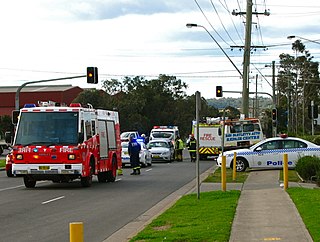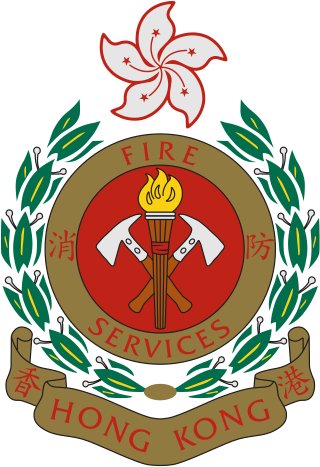
Emergency services and rescue services are organizations that ensure public safety, security, and health by addressing and resolving different emergencies. Some of these agencies exist solely for addressing certain types of emergencies, while others deal with ad hoc emergencies as part of their normal responsibilities. Many of these agencies engage in community awareness and prevention programs to help the public avoid, detect, and report emergencies effectively. Emergency services are often considered first responders, and typically have dedicated emergency vehicles.

An emergency is an urgent, unexpected, and usually dangerous situation that poses an immediate risk to health, life, property, or environment and requires immediate action. Most emergencies require urgent intervention to prevent a worsening of the situation, although in some situations, mitigation may not be possible and agencies may only be able to offer palliative care for the aftermath.
Computer-aided dispatch (CAD), also called computer-assisted dispatch, is a method of dispatching taxicabs, couriers, field service technicians, mass transit vehicles or emergency services assisted by computer. It can either be used to send messages to the dispatchee via a mobile data terminal (MDT) and/or used to store and retrieve data. A dispatcher may announce the call details to field units over a two-way radio. Some systems communicate using a two-way radio system's selective calling features. CAD systems may send text messages with call-for-service details to alphanumeric pagers or wireless telephony text services like SMS. The central idea is that persons in a dispatch center are able to easily view and understand the status of all units being dispatched. CAD provides displays and tools so that the dispatcher has an opportunity to handle calls-for-service as efficiently as possible.

The Incident Command System (ICS) is a standardized approach to the command, control, and coordination of emergency response providing a common hierarchy within which responders from multiple agencies can be effective.
Firefighting jargon includes a diverse lexicon of both common and idiosyncratic terms. One problem that exists in trying to create a list such as this is that much of the terminology used by a particular department is specifically defined in their particular standing operating procedures, such that two departments may have completely different terms for the same thing. For example, depending on whom one asks, a safety team may be referred to as a standby, a RIT or RIG or RIC, or a FAST. Furthermore, a department may change a definition within its SOP, such that one year it may be RIT, and the next RIG or RIC.
The National Incident Management System (NIMS) is a standardized approach to incident management developed by the United States Department of Homeland Security. The program was established in March 2004, in response to Homeland Security Presidential Directive-5, issued by President George W. Bush. It is intended to facilitate coordination between all responders. The system has been revised once, in December 2008. NIMS is the common framework that integrates a wide range of capabilities to help achieve objectives.
The London Emergency Services Liaison Panel (LESLP) consists of representatives from the following agencies:

The Hong Kong Fire Services Department is an emergency service responsible for firefighting and rescue on land and sea. It also provides an emergency ambulance service for the sick and the injured and gives fire protection advice to the public. It is under the Secretary for Security who heads the Security Bureau.

Aircraft rescue and firefighting (ARFF) is a type of firefighting that involves the emergency response, mitigation, evacuation, and rescue of passengers and crew of aircraft involved in aviation accidents and incidents.
A gold–silver–bronze command structure is a command hierarchy used for major operations by the emergency services of the United Kingdom.
The New Zealand Fire Service was New Zealand's main firefighting body from 1 April 1976 until 1 July 2017 – at which point it was dissolved and incorporated into the new Fire and Emergency New Zealand.
ETHANE is a mnemonic indicating a protocol used by emergency services to report situations which they may be faced with, especially as it relates to major incidents, where it may be used as part of their emergency action principles. An alternative mnemonic METHANE adds an additional prompt "Major Incident Declared?" to ensure consideration is given to if the response may challenge the available resources and so necessitate initiating contingency plan measures.

The Los Angeles Police Department (LAPD), the primary law enforcement agency of Los Angeles, California, United States, maintains and uses a variety of resources that allow its officers to effectively perform their duties. The LAPD's organization is complex with the department divided into bureaus and offices that oversee functions and manage specialized units. The LAPD's resources include the department's divisions, transportation, communications, and technology.
Firelink or FireLink is a wide area radio system in England, Wales, and Scotland for fire services. The system which supports both voice and data communication was designed to replace a patchwork of analogue systems with a modern wider area digital system. It provides new functionality – notably resilience and interoperability with other FRS and emergency services - which previous major incidents have identified as important.

A mass casualty incident describes an incident in which emergency medical services resources, such as personnel and equipment, are overwhelmed by the number and severity of casualties. For example, an incident where a two-person crew is responding to a motor vehicle collision with three severely injured people could be considered a mass casualty incident. The general public more commonly recognizes events such as building collapses, train and bus collisions, plane crashes, earthquakes and other large-scale emergencies as mass casualty incidents. Events such as the Oklahoma City bombing in 1995, the September 11 attacks in 2001, and the Boston Marathon bombing in 2013 are well-publicized examples of mass casualty incidents. The most common types of MCIs are generally caused by terrorism, mass-transportation accidents, fires or natural disasters. A multiple casualty incident is one in which there are multiple casualties. The key difference from a mass casualty incident is that in a multiple casualty incident the resources available are sufficient to manage the needs of the victims. The issue of resource availability is therefore critical to the understanding of these concepts. One crosses over from a multiple to a mass casualty incident when resources are exceeded and the systems are overwhelmed.

Firefighting in the United States dates back to the earliest European colonies in the Americas. Early firefighters were simply community members who would respond to neighborhood fires with buckets. The first dedicated volunteer fire brigade was established in 1736 in Philadelphia. These volunteer companies were often paid by insurance companies in return for protecting their clients.

The New York City Fire Department Bureau of Emergency Medical Services is a division of the New York City Fire Department (FDNY) in charge of emergency medical services for New York City. It was established on March 17, 1996, following the merger of the FDNY and New York City Health and Hospitals Corporation's emergency medical services division. FDNY EMS provides coverage of all five boroughs of New York City with ambulances and a variety of specialized response vehicles.
RPM-30-2-Can Do is a mnemonic device for the criteria used in the START triage system, which is used to sort patients into categories at a mass casualty incident. The mnemonic is pronounced "R, P, M, thirty, two, can do."
ISO 22300:2021, Security and resilience – Vocabulary, is an international standard developed by ISO/TC 292 Security and resilience. This document defines terms used in security and resilience standards and includes 360 terms and definitions. This edition was published in the beginning of 2021 and replaces the second edition from 2018.








